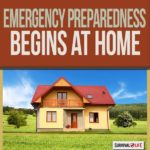
Every prepper knows what it’s like to pack your bug out bag and think of all the scenarios when you might need it, from the common to the most outlandish. But the truth is we hope we never actually have to use our bug out bag. Just because we prepare for these situations and know what to do doesn’t mean we want or hope for them to happen. We’re just aware of the possibilities and know how important it is to be ready.
Hopefully, you won’t ever need your E/PAK or bug out bag. However, being prepared for such an eventuality is good for easing your mind.
My personal desire is that I’ll never need my E/PAK for an emergency. Yet, it will always be in a special location in my home near a protected exit, filled with all the things I’d need for hunkering down when a natural disaster, such as a wind, ice, or snowstorm, or a people-caused disaster causes a power outage.
Lots of people tell me they plan to bug out. Personally, I plan to stay at home unless a lifethreatening disaster requires my departure. There is no place I want to go––except maybe to an expensive hotel. However, with my personal 72-hour; kit, I could even endure a public shelter, if necessary.
I’ve spent a weekend in a church recreation hall during an ice storm with several other families––it wasn’t too bad, except for the lack of privacy. I’ve also spent a few days at my parents’ home––all the kids, grandkids, and all their collective dogs.
But heading for the unfamiliar hills, living in the wilderness fraught with unknown dangers, chasing wild animals with switches, fending off others in a similar plight to mine, while trying to maintain an urban lifestyle, does not seem a good option to me. The very thought of getting on the freeway or city streets during or following a disaster, competing for space with all those folks carrying handguns (even if they do have permits) and other nefarious weapons, is just a little frightening. On the streets I cannot defend myself adequately. At home, I can maintain my independence as long as I have my personal provisions to sustain me until the crisis is past.
My personal plans in the case of a local disaster––such as an electrical failure––are to make the best of a bad situation, enjoy the intervention in my normally extra-long workday, and spend it with my wife (and the dogs) in the ensuing peace and quiet. It would be a moment to have another honeymoon, savor the quiet, and listen to all those archived short-wave radio programs I’ve wanted to listen to for ages…
But If You Must Bug Out…
However, if you must leave home unexpectedly (perhaps like those in California who were forced to evacuate due to wildfires), be sure to have the following information ready to go with you:
- daily contact details for family members
- local reunion points
- out of area contacts
- pertinent family operating data
You should record information about the daily whereabouts of family members and how they can be contacted. It might be appropriate to keep this information on the family bulletin board (in our house it’s the refrigerator), in each E/PAK, and even in your wallet. Remember to update as contacts or locations change.
Keep in mind that during times of natural or people-caused disasters, local telephone service is often disrupted. Therefore, each member of the household should carry the name, phone number, and address of a person who is designated as an out-of-area contact. (Note: long distance lines often remain useable during emergencies. Additionally, the phone company’s emergency network is the pay phone system. It will be restored before residential lines.)  If separated, each family member should call the designated out-of-area contact and communicate his particular situation within a certain period of time, reporting his physical condition, his location, and other information as previously agreed upon. Keep adequate change in your E/PAK for making pay phone calls.
Emergency Preparedness Begins at Home
Responsibility begins in your own home. You are responsible for protecting yourself, your family, and your property to the best of your capability. This entails planning and preparing your own resources to:
(1) Respond to,
(2) Mitigate the effects of, and
(3) Recover from natural and people-caused disasters that can become your personal disaster(s).
The preparation level should exceed the risk level of the expected and unexpected emergencies or disasters in a particular geographic location.
Being prepared requires learning about potential disasters and emergencies, knowing first aid, CPR, and other life-saving skills. Adaptability and independence are critical qualities to develop in one’s preparation efforts.
Unfortunately such self-reliance skills are not taught in most schools. Usually they are learned at the hands of bad experience––a tough taskmaster, indeed! There is no easy way to become self-reliant. It requires work, meaningful efforts in selfeducation, and often a large measure of self-denial. Utilize all the knowledge you can gain to prepare for the disasters which could cause you and your family more than the loss of your car, your property, or your crops.
The above article was taken from Dr. Prepper’s Making the Best of the Basics by James Stevens, which is now available to Survival Life readers at half-price. Just click here and enter coupon code present to get your copy for only $19.97!
To Bug Out or Stay In? That is the Question
http://bit.ly/1tFpNzA
#preppers
No comments:
Post a Comment